British journalist Charles Mackay’s 1841 book, Extraordinary Popular Delusions and the Madness of Crowds, made Holland’s “Tulip Mania” speculative bubble legendary. 170 years later, Ralph R. Reiland has a great piece at the American Spectator this week titled “Murder, Tulips, and Taxes.” As Reiland describes it, Chicago’s Ruling Class has been undergoing its own form of tulip mania since the late 1980s. I suppose it’s a way to take their minds off more intractable issues that political correctness prohibits them from solving:
The tulips on Michigan Avenue come with an annual maintenance cost of $250,000. They’ll be gone in a few days, replaced with thousands of summer bloomers, and then by truckloads of mums.
“Flowers make people calm,” said former Mayor Richard M. Daley, kicking off an effort in 1989 to make Chicago “the greenest city in America.”
The mayor probably had that backwards. Rather than tulips making people calm, I think calm people plant tulips, while the un-calm do things like crack.
Either way, the mayor put the flowers where the people were already calm, rather than in the killing fields of the city.
“In 2009, Chicago recorded 458 homicides and New York 471 — when New York’s population is nearly three times as large as Chicago’s,” reported the Christian Science Monitor last year. *
The murders were on the sorry streets of the city where there are more prostitutes than tulips.
Even so, I doubt if a “Flowers for the downtrodden” or a “Tulips for the Fuming” planting effort would have worked to reverse the city’s escalating murder rate.
In any case, with 500,000 trees already planted and park space in the city expanded to 7,730 acres, the city is spending $10 million a year on new trees, flowers and shrubbery.
With more parks than any other U.S. city, the annual budget for the 550 parks is more than $300 million, the largest parks budget in the nation — nearly a million dollars per day.
The gardens are supposed to pull people back to the city.
In the first decade, the 1990s, the population, especially among yuppies, grew 4 percent, the first decade of growth in 50 years.
New census data, however, show the city’s population down by 6.9 percent since 2000.
As Weiland notes at the end of his article, look for additional population shrinkage — but lots more tulips! — in the coming months and years in the Second City and its suburbs.
* Pat Moynihan would not be surprised.
(H/T: Jimmie Bise.)










Join the conversation as a VIP Member